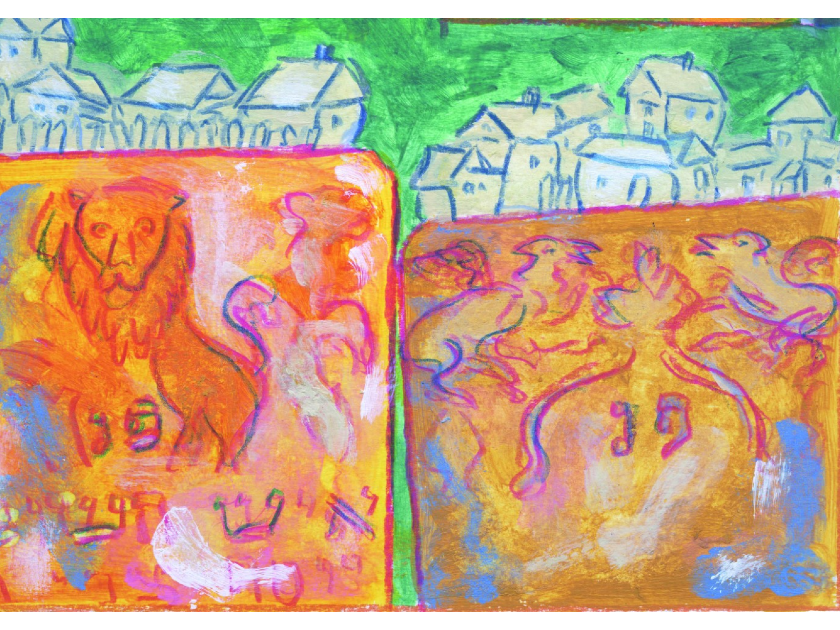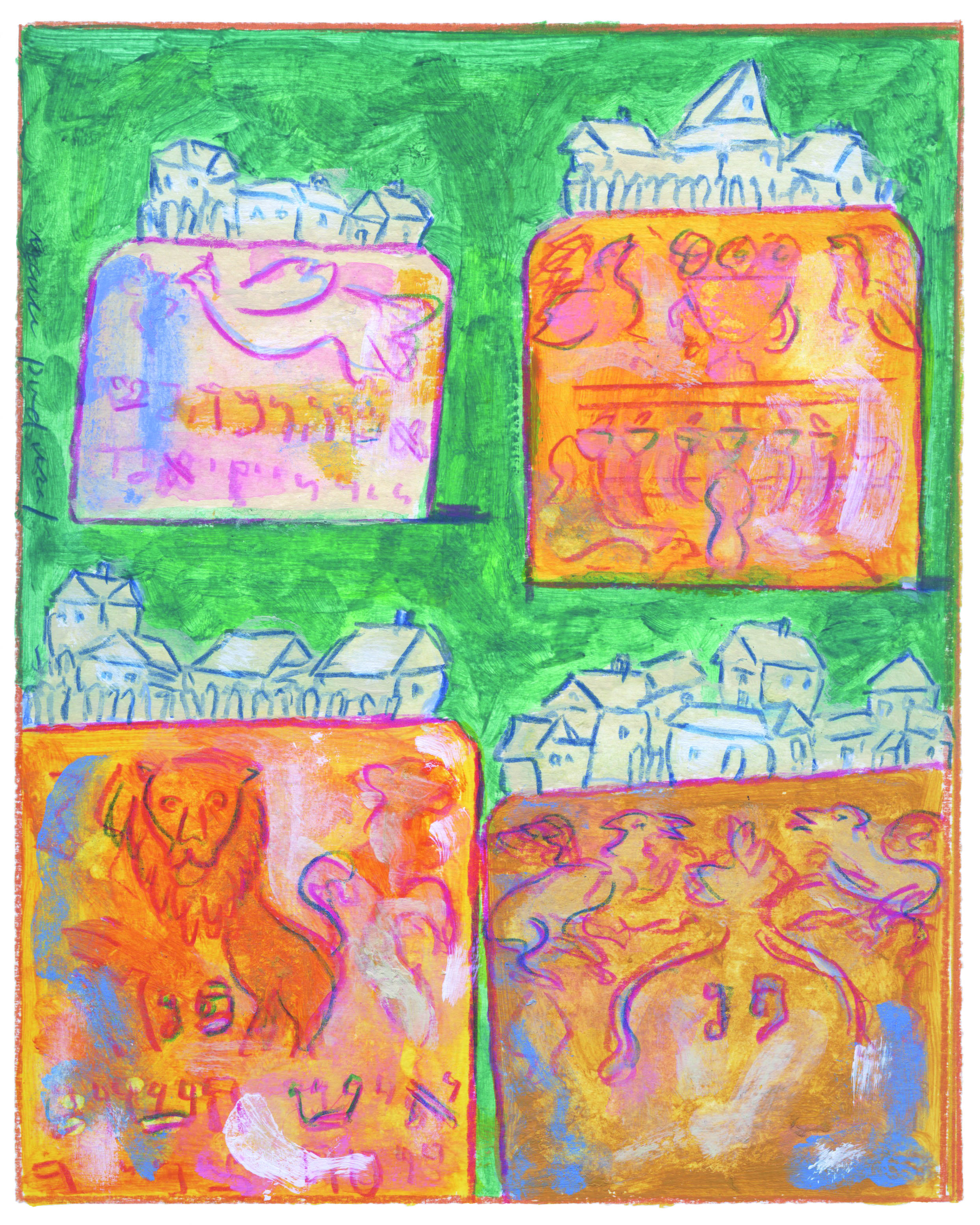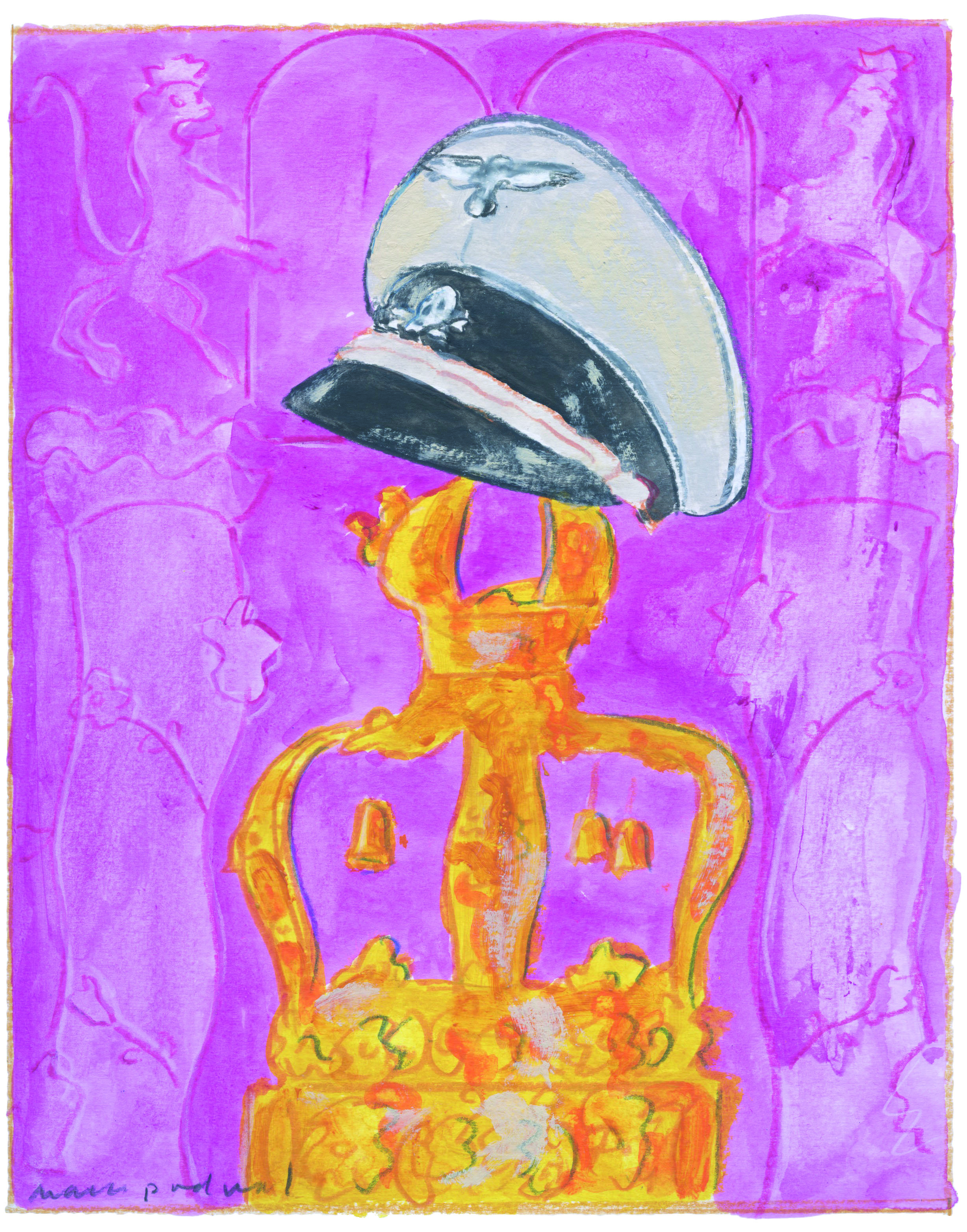
Art by Mark Podwal
Acclaimed illustrator Mark Podwal discusses his career, creative process, and work for Elie Wiesel’s poem The Tale of a Niggun with Ada Brunstein.
Ada Brunstein: When you were in kindergarten your teacher noticed one of your drawings and only then asked you what your name was. You wrote, “My existence depended on my drawing.” Does it still? If so, how?
Mark Podwal: A childhood illness caused me to miss the first days of kindergarten. As a result, my name was not on the class roster. Only when my teacher noticed my drawing of a train was I recognized as existing in that classroom. Freud, in his biographical study of Leonard da Vinci, explained the peculiarities of the artist’s character on the basis of his childhood, focusing on a childhood memory. While Freud concluded Leonardo’s childhood memory was a fantasy, my childhood memory recalled an actual experience. Since early adolescence I intended to become a physician. When I grew up in Queens, New York, in the 1960’s if you excelled in school you became a doctor or a lawyer. You did not become an artist. Nevertheless, in medical school, art became my dual career, perhaps destined by my kindergarten experience.
AB: You rediscovered your love of drawing in medical school. Was that triggered by the drawings that fill medical books, or was it an escape from the rigors of medicine, or something else entirely?
MP: Definitely not inspired by medical illustrations. A Yiddish proverb says, “If you want to give God a good laugh, tell Him your plans.” In medical school, I planned on becoming a surgeon. It seemed natural since having a talent for art I was skilled with my hands. While drawing a caricature of a pharmacology professor, a classmate noted, “You’ve missed your calling.” Somehow that comment bothered me. After attending a Vietnam War protest, I volunteered to create anti-war posters for the Moratorium Committee.
Many thousands were printed and the positive feedback motivated me to set aside time for drawing. The creativity was a needed diversion from medical school’s pressures. Considering that a surgeon’s life would leave little time to pursue art, I followed the advice of my professor, the eminent immunologist Edward C. Franklin, to choose a specialty such as dermatology, radiology, or pathology that would afford time for art. Dr. Franklin’s presidential address to the American Society for Clinical Investigation in 1974 included slides of my drawings.
AB: Your first published book was a collection of political drawings based on events in the 1960s. That book led you to the New York Times, for which your first drawing was about the Munich massacre. Can you describe how you went from learning about those events to rendering them in drawings?
MP: Drawing anti-war posters led to drawing ink images, which chronicled those tumultuous years. The first New York Times Op-Ed page art director — on seeing the drawings from my first book, “The Decline and Fall of the American Empire” (forward by Peter Fonda) — commented that my work was reminiscent of the power of George Grosz’s satirical depictions of post-World War I Germany and the rise of Nazism. Impressed by my art, he recruited me to draw for the Times. My Munich massacre drawing was published as the first Op-Ed Art — a picture without an accompanying article. That drawing was later exhibited in Paris at the Musée des Arts Décoratifs in the Palais du Louvre.
AB: You wrote that art can be a form of prayer. How?
MP: Franz Kafka once described writing as a form of prayer, and that definition has resonated with me. When my textiles for Prague’s gothic Old-New Synagogue were dedicated, I mentioned in my speech how for me, “art is a form of prayer.” I especially referenced Kafka because he had attended that synagogue. Unbeknownst to me were books such as Drawing to God, about how drawing can itself be prayer; it can visualize prayer, and it can inspire prayer.
Franz Kafka once described writing as a form of prayer, and that definition has resonated with me.
AB: Your work has been exhibited in the Terezin Ghetto Museum, the Berlin, Paris, and Prague Jewish Museums, among others. In recent years we’ve seen an increase in antisemitism. Can art help fight it?
MP: Medieval art promoted antisemitism to an illiterate public. Cathedral portal figures Ecclesia and Synagoga were symbolic representations of the Christian and Jewish faiths, portrayed by two female sculptures. Triumphant Ecclesia, represented the Church. Synagoga, forlorn and blindfolded — blind to Christianity’s “truth” — represented Judaism. When my portfolio of prints, “All this has come upon us…” was acquired by the Bavarian State Library in Munich, the library’s director described the images as “really disturbing and thought-provoking that gives you an insight in the long, long history of anti-Semitism to its culmination in the barbarous Nazi Era…we are collecting, as we like to emphasize, for eternal times. And so having this Portfolio in our collection is at least also a very small contribution to remember forever what German people in the Nazi Era has done to the Jewish people.” Nearly fifty institutions, including the Vatican Pontificia Università Urbaniana and Yad Vashem, have acquired that portfolio. Through my art I’ve tried to educate against antisemitism. Yet, I’m unsure how effective art is as a weapon against such hatred. Even so, according to Pirkei Avot, “It is not your responsibility to finish the work of perfecting the world, but you are not free to desist from it either.”
AB: You’re a doctor. How do you manage an award-winning artistic career alongside the demands of medicine. Do the two worlds intersect?
MP: During my interview for a dermatology residency, the interviewer complimented me on my drawings of Bellevue Hospital for the medical school yearbook. He noted that since dermatology is a visual specialty an artist’s observational skills would enhance their diagnostic acuity. Cynthia Ozick refers to the two worlds intersecting in her essay on my art, “Ink and Inkling,” she states “his canny pen is attentive to the human obligation to see, with a doctor’s eye, the terrifying wounds of our world.”

Art by Mark Podwal
AB: You’ve written several children’s books, including Jerusalem Sky. What messages do you want to pass on to the next generation?
MP: Maurice Sendak, who contributed a blurb for the second printing of Jerusalem Sky, said that he wrote not for children nor adults. He just wrote. So do I. The ecumenical message from Jerusalem Sky is “Perhaps possessing Jerusalem is like trying to own the sky.”
AB: You collaborated with Elie Wiesel on several books. How did your relationship begin?
MP: In January 1977, the French captured the terrorist Abu Daoud, the Munich massacre’s mastermind. A West German extradition request was refused on grounds that forms had not been properly filled out and the French put Daoud on a plane to Algeria. Elie Wiesel condemned the affair in an open letter to President Giscard D’Estaing, published as a full-page ad in the New York Times. To voice my outrage I drew the Eiffel Tower with a thought bubble containing an oil well. Shortly after my drawing appeared in the Times, Elie sent a brief handwritten note full of generous praise saying we should meet. That’s how our collaborations and friendship began.
AB: Describing your work, Wiesel wrote, “such is the power of this artist: he captures what death has forgotten to take.” Is that something you consciously aim for in your work?
MP: Whereas Elie wrote numerous times about my art, that comment moves me most. Though “capturing what death has forgotten to take” has not been a conscious aim, the subconscious usually contributes content an artist expresses during artistic creation. At times, writers better verbalize what I thought to visualize.

Art by Mark Podwal
AB: Did you create the illustrations in The Tale of a Niggun after Elie Wiesel passed? If so, what was your collaborative process when he was alive, and how did you experience this book without him?
MP: After Elie died in 2016, his son Elisha emailed me, “Mark, you were such a close friend to my father — he truly trusted you, loved collaborating with you, and cared about your friendship. And he was always moved by what you saw in Judaism and enabled others to see.” When illustrating Elie’s works, Elie trusted me to draw whatever I imagined. Only three times did he offer advice. The first was not to draw the face of Rabbi Loew — who legend claims created a golem — since there are no known lifetime portraits. Second, not to draw Hebrew letters for decoration. Third, not to draw Holocaust victims. I was unaware of the poem The Tale of a Niggun until last year, when Elie’s agent, Georges Borchadt, asked if I’d illustrate it. Working on the illustrations I kept thinking about my time with Elie — our visit to his birthplace Sighet, to Auschwitz and Buchenwald, and attending his Nobel Prize ceremony in Oslo.
AB: One of the more haunting images in the book shows small houses seemingly resting atop barbed wires with two treble clefs enlarged and set to the left. The drawing is deceptively simple — black and white lines form images that seem deliberately devoid of precise details. But seen as a whole, the drawing looks like sheet music. The wires are the measures, the houses the notes. Can you talk about the process of creating an image that evokes so much — captivity, terror, music, community — but is rendered with so little?
MP: I rarely draw without the image already pictured in my mind. The idea comes about as a sort of free association. Since the essence of the story’s redemption is a niggun—a wordless song sung by Ḥasidic Jews to elevate the soul to God — one of the ten images had to depict the niggun. Music staffs of barbed wire symbolize the Holocaust, and the houses denote the story’s shtetl. It’s the book’s only black and white drawing. Color would be a distraction, as words for a niggun would be a distraction.
AB: Your work so clearly evokes the Jewish communal experience. Some of that comes through your depiction of artifacts, such as menorahs, Torahs, and yads. But in your work a menorah is never just a menorah. In one image, the menorah sprouts flowers; in another it is made of bones. How do you turn a ceremonial object into something that tells a story beyond just the one it is meant to tell?
MP: Drawing for the New York Times very much influenced my art. The role of Op-Ed Art was not to “illustrate,” but to expand the impact of the word, as opposed to a literal interpretation. Literary critic Harold Bloom said about our book Fallen Angels, “Mark Podwal is in every sense an illuminator.” The idiom “illumination” denotes revealing information or details about something; to clarify or to help understand something. I was very fortunate to be friends with the artist Saul Steinberg, perhaps best known for his New Yorker covers. Saul once told me that, of course, one disregards the first ten ideas since everyone will think of those. Much of my art involves inventing visual metaphors adapted from Jewish symbols and iconography. A well-known art critic commented, “Mark, you’re the master of metaphor.” I wish someday he’d write that in a review.
AB: Do you doodle during Zoom meetings like the rest of us?
MP: No. I haven’t doodled since attending medical school lectures.
AB: What are you working on next?
MP: I’ll have two books published 2021: A Collage of Customs (Hebrew Union College Press), and a revised color edition of A Jewish Bestiary (Penn State University Press, publisher of Heinrich Heine’s Hebrew Melodies with my illustrations).
Ada Brunstein is the Head of Reference at a university press.